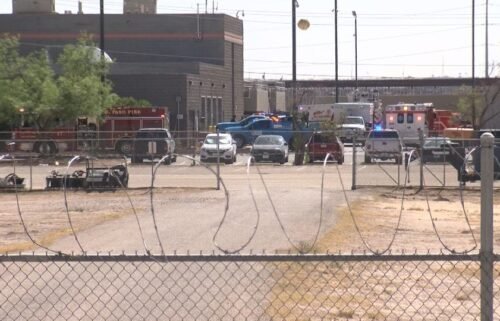Amid the migrant surge, a look at how an ‘Eye in the Sky’ gives CBP an advantage
EL PASO, Texas -- ABC-7 was given rare access to see what officers of the Customs and Border Protection crew on board a military style Blackhawk helicopter can see, which in this case, was the detention of several migrants who illegally crossed into the U.S. and were trying to hop into one of the cars on a Santa Theresa road.
ABC-7's Saul Saenz spoke with CBP officers about the mission during he flight.
Agents pointed out to Saul what they believe is the point of entry from the air, on board the chopper, a cluster of what's left of heavy foot traffic in a remote desert area near the border barrier.
According to the director of El Paso Air Branch, those footprints are not supposed to be there because there is nothing around for miles.
"And as you can see from the vastness out in front of us, there's no reason for those to be there. Not in that amount of volume. Which means someone might've crossed today? Today, yesterday," said John Stonehouse, the person responsible for giving ABC-7 access to a fly-along.
The chopper circls back around because agents wanted to show ABC-7 photographer, Jerry Najera, what looks like a makeshift ladder on the U.S. side not far from the footprints on the Mexico side.
"They'll build ladders out of rebar. An they'll throw them against the fence. And they'll climb up and over that. And then they'll jump from the other side. Or they'll try to lower somebody down. But we get a lot of laying back, knee injuries, ankle injuries out here," said Stonehouse.
The Air Patrol also helps the injured.
However, they are not a medivac, meaning they can not airlift a patient and transport them to a hospital.
"We don't have advance life support on our aircraft," said the director.
"So we'll spot a location for medivac and we'll relay that information to them. But depending on the medivac rules, they might not land on field. So what happens is we'll pick them up, and take them to a hard pack, or a highway landing, or something like that. And then we'll transition the patient over to medivac," he added.
The chopper also carries several cases of bottled water. If they see someone, non-us citizens are crossing over rough terrain on a really hot and they believe they are dehydrated, they'll actually drop water on that particular group so they can hydrate themselves.
Chopper crew members show Najera the rough terrain migrants sometimes have to cross near Mount Cristo Rey.
They point out crevices undocumented immigrants use to hide to avoid being caught.
And its not just migrants team members on this helicopter locate and help.
They help U.S. citizens as well.
Stonehouse shared pictures of a Franklin Mountain hiker rescued in March.
Proving the skill set of the CBP pilots, only the front wheels of the helicopter rest on the mountainside while rescue workers load the victim onto the helicopter.
Back on the ground, it will be a while before Customs and Border Protection can determine if the same migrants apprehended along the Santa Theresa road waiting to be picked up by a driver,are the same that crossed over the border barrier using the makeshift ladder.
But these team members take comfort in the fact the group did not need to be rescued, and they will not venture further illegally into the U.S. -- for now.
ABC-7 Sunday Xtra host Saul Saenz interviewed Stoneshouse for more depth on the crew's mission.
The director shares what crew members look for when they become the eyes in the sky for Border Patrol agents.
Watch ABC-7 Xtra Sunday after ABC-7 at 10pm.

